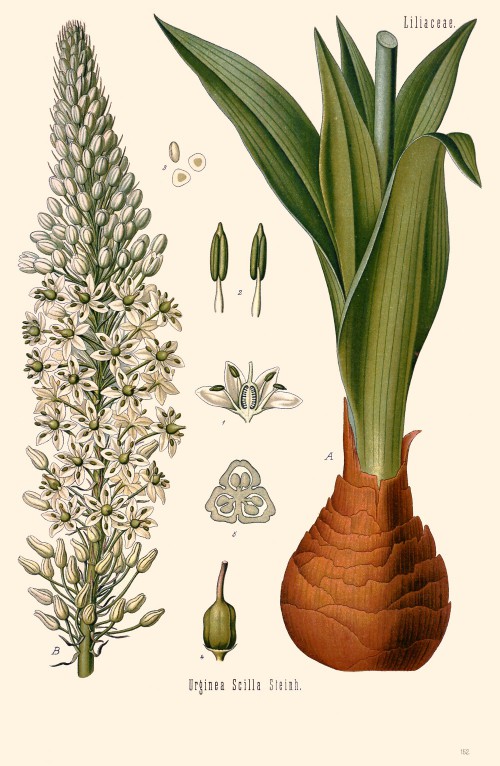Drimia maritima (L.) Stearn - syn.Urginea maritima (L.) Baker; Scilla maritima L.; Urginea scilla Steinh. - Liliaceae
squill, sea squill, sea onion, Meerzwiebel
Perennial herb, native to southern Europe (Spain), the Mediterranean, and northern Africa; large bulb up to 15cm wide; leaves laethery, ark green, usualy 50cm long, coming up in sping and dying away in summer; inflorescence developing in autumn, reaching up to 150cm in height; petals white with green.
Intoxication effects „… resembling those seen with cardiac glycoside intoxication included nausea, vomiting, seizures, hyperkalemia, atrioventricular block and ventricular arrhythmias resembling digitalis toxicity.“
[Urginea maritima (squill) toxicity. Tuncok, Yesim, et al., Clinical Toxicology, Vol.33(1), 1995, 83-86]
The sliced and rapidly dried fleshy inner bulb scales (Scillae bulbus) were used as heart tonic (NYHA I and II) and diuretic. D.maritima contain cardiac glucosides of the bufadienolide type like glucoscillaren A and scillaren A (which yield proscillaridin A on hydrolysis) with positive inotropic and weakly negative chronotropic heart activity, and expectorant, diuretic and emetic effects. „Squill powder or extracts are poisonous and should be used under professional supervision.“
[Medicinal Plants of the World. Ben-Erik Van Wyk and Michael Wink, Pretoria 2004, 331]
From thirty three compounds obtained from the bulbs of Urginea maritima, nine were cardiotonic bufadienolides (mainly scillaren A, scilliroside and proscillaridin A) and one a dihydro-benzofuran-type neolignan glucoside.
[Bufadienolides and a New Lignan from the Bulbs of Urginea maritima. Iizuka, Masaru, Tsutomu Warashina, and Tadataka Noro. Chemical and pharmaceutical bulletin Vol.49 (3), 2001, 282-286] https://www.jstage.jst.go.jp/article/cpb/49/3/49_3_282/_pdf

Drimia maritima (L.) Stearn as Urginea scilla Steinh., Köhler,F.E., Medizinal Pflanzen, vol.2, t.162 (1890)
http://plantgenera.org/species.php?id_species=359953